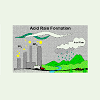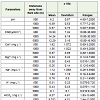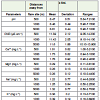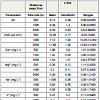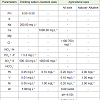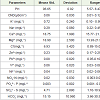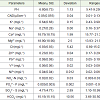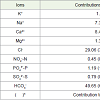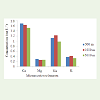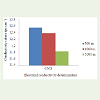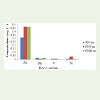Research Article
Gas Flaring and Rainwater Composition - A Negative Synergy: A Case Study of Utorogu Community in Niger-Delta, Nigeria
Benjamin Chibuzo*
Department of Chemical Sciences, Adekunle Ajasin University, Akungba- Akoko, Ondo State, Nigeria
Corresponding author: Benjamin Chibuzo, Department of Chemical Sciences, Adekunle Ajasin University, Akungba- Akoko, Ondo State, Nigeria, Tel: +2348102333535; E-mail: benjamin.ejelonu@aaua.edu.ng
Citation:Chibuzo EB. Gas Flaring and Rainwater Composition - A Negative Synergy: A Case Study of Utorogu Community in Niger-Delta, Nigeria. J Environ Soc Sci. 2016;3(2): 124-2.
Copyright © 2016 Chibuzo EB. This is an open access article distributed under the Creative Commons Attribution License, which permits unrestricted use, distribution, and reproduction in any medium, provided the original work is properly cited.
Journal of Environmental and Social Sciences | Volume: 3, Issue: 2
Submission: 19/08/2016; Accepted: 15/09/2016; Published: 30/09/2016
Abstract
The environment of the Niger Delta has been degraded through oil exploration activities. The soil, ground and surface water have remained the deposit sites for the crude oil/natural gas processing wastes. Although some studies exist on the pollution status of the region, the situation of a number of communities has not been investigated. This study therefore, examined the impacts of gaseous emissions from the flaring of gases at the gas plant located within Utorogu community through rainwater samples collected from the community. The rainwater samples were collected at 500 m, 1000 m and 5000 m away from the flare site of the gas plant (downwind) and analyzed for physico-chemical properties and heavy metals. For a control study, rainwater samples were collected from Okere-a community outside the same local government area with Utorogu. All the parameters were determined in triplicates using standard analytical methods; and the data generated analyzed using correlation test. The rainwater chemistry varied little with time and distance. The findings suggest that rainwater within the Utorogu community are well within acidic pH range (pH < 6.50), contain acidic radicals like PO43-, SO42-, NO2 - and HCO3-; and are veryrich in both micronutrient elements and heavy metals; while that of the control area are less acidic and less rich in heavy metals. Thus, if flaring of gas bythe crude oil processing plant is not checked, there is a tendency of increasing acidic and metal polluted rainwater within this community. The reductionof gaseous emissions whitim this community would significantly decrease or slow down the acidification of water bodies and reduce stress to forests. In addition, the lifespan of building materials and structures of cultural importance would be lengthened. Also, the reductions in emissions would help to protect public health. The present study examines a three year profile (1998-2000) of gas flaring activities in Utorogu oil producing community; and its outcome would provide information on the potential environmental impacts of gas flaring within the given oil producing community.
Keywords:
Environment; Oil exploration activities; Gaseous emissions; Heavy metals; Public health
Introduction
Anywhere, the petroleum industry is a power-generating entity. When significant deposits of oil were discovered in the 15th century, this fossil fuel appeared to offer limitless source of energy to drive development. While oil and the energy it supplies provide multiplebenefits to human society, every stage in the life cycle from explorationto use can have harmful impacts on health and environment[1].
Oil production has been going on in Nigeria for over 45 yearstogether with the flaring of natural gas. Flaring is a means of safelydisposing of waste gases through the use of combustion. Data collected by the Alberta Energy and Utilities Board (EUB) in Canada shows thatin 1996 about 92% of gases were conserved or used in some manner.The remaining 8% was flared. This socially responsible attitudetowards gas conservation, as demanded partly by environmentalrequirements in Canada and other advanced countries, does notapply in Nigeria. Nigeria is estimated to have 187 Trillion Cubic Feet(TCF) of proven natural gas reserves as of December 2010 accordingto the BP Statistical Review of World Energy- a value which makesNigeria the ninth largest natural gas reserve holder in the world andthe largest in Africa [2]. Due to unsustainable exploration practices coupled with the lack of gas utilization infrastructure in Nigeria, the country flares 75% of the gas it produces and re-injects only 12% to enhance oil recovery. It has been reported that of the 3.5 billion cubic feet (99,000,000 m3) of Associated Gas (AG) produced annually, 2.5 billion cubic feet (71,000,000 m3), or about 70% is wasted via flaring, supporting the fact that Nigeria flares more natural gas associated with oil extraction than any other country. This amounts to about 70 million tonnes of carbon dioxide [3].
The gaseous emission products from gas flaring activitiescan be deposited (dry or wet) into water bodies, onto soil andvegetation [4]. Residents of oil-producing areas in Nigeria, have long complained about how their corrugated roofs have been corroded by the composition of the rain that falls as a result of flaring [5]. The primary causes of acid rain are emissions of sulphur dioxide (SO2) and nitrogen oxides (NOx), which combine with atmospheric moisture to form sulfuric acid and nitric acid respectively [4-6]. The graphic representation of how acid rain falls is given in Figure 1 above [7]
Acid rain causes acidification of lakes and streams. It contributesto damage of trees at high elevations and accelerates the decay ofbuilding materials and paints, including irreplaceable buildings,statues, and sculptures that are part of our nation’s cultural heritage.Prior to falling to the earth, SO2 and NOx gases and their particulate matter derivatives, sulphates and nitrates, contribute to visibility degradation and harm public health [7,8]. In the Delta, an oily hue is often observed on collected rainwater. The continued process of gas flaring has not only meant that a potential energy source and source of revenue-has gone up in smoke, but it is also a major contributor to air pollution and CO2 emission [9]. Literatures have shown that the gas flaring of other carbonaceous fuels, apart from producing oxides of carbon (COX), sulfur (SOX) and nitrogen (NOX), water vapour, also produces volatile and non-volatile heavy metals such as Lead (Pb), Mercury (Hg), Cadmium (Cd) and Arsenic (As) [10]. Also, a greater number of people within the community housing the gas plant may be exposed to the risk of toxic metals (especially vanadium) through the usage of harvested rainwater [11].
Nigeria gets about 90 per cent of its petroleum from the sprawlingDelta in the south, an area inhabited by “minority†ethnic groupssuch as the Itsekiris, Urhobos, Ijaws, Ibibios, Ogonis, Kalabaris, Efiks,Ikwerres, Ilajes and Ibibios. In spite of the enormous resources itgenerates for the national coffers, the Niger Delta is perhaps the leastdeveloped area of the country. The Delta lacks good roads, electricity, potable water and good schools. Unemployment is high because the rivers, creeks and streams which provide people with their mainsource of livelihood fishing have been extensively polluted throughthe activities of the more than a dozen oil companies operating in thearea [12,13].
No comprehensive study is known to have been carried out into thehealth impacts of gas flaring on communities in the Delta, includingthe level of pollutants in the food chain. However, communities firmly believe that the flaring is damaging their health, reducing crop production and damaging their homes. While other factors may beat play, the lack of attention paid to this crucial issue, means thatvillagers’ questions and fears are unanswered. Conviction that oilproduction is such damaging force fuels community anger againstoil companies. This work therefore, through the chemical analysis ofrainwater samples collected within the Utorogu community wouldhelp to highlight further the impacts gas flaring activities have on the environment and the general health or well being of the communitydwellers.
Materials and Methods
Site Description
The Niger-Delta area of Nigeria is endowed with petroleumresources. Daily a lot of oil prospecting and processing activitiesare carried out with concomitant release of effluent, gaseous wastes(resulting from the flaring of residual gases) into the environment,and the improperly handling of these wastes with time can result intopollution of the environment in the vicinity of the oil installations andbeyond. The inhabitants of the Niger Delta are farmers and fishermen.They live off of the land and are dependent upon the productivity ofthat land for survival. Destruction of farmland by oil/gas prospectingand processing activities has pushed tens of thousands of people tothe brink of starvation and prevented income generation from thatland. Fisheries, farms, mangrove swamps, rain forests and water haveall suffered severe damage from the impacts of petroleum explorationand energy consumption on these communities, threatening thesurvival of the people of the Niger Delta.
The Utorogu community belongs to the Ughelli-North Local Government Area of Delta State, Nigeria. It houses the Gas Planta natural gas processing plant, which processes natural gas and associated crude oil. Ughelli-North falls within latitude 5 °301 N and longitude 5 °591 E.
Analytical Procedures
pH and Electrical conductivity were determined insituionthe field while the heavy metal ion samples were preserved withconcentrated nitric acid (pH < 2). All samples were transported to thelaboratory for immediate further analysis in ice-bergs below 5 °C. Allthe physico-chemical parameters and heavy metal ions analyzed forall the samples were analyzed using standard analytical methods [14].
Results and Discussion
Results
The physico-chemical properties and level of heavy metals inrainwater samples collected from Utorogu Gas Plant location as wellas those of Okere Area 1 and 2 Reference locations are contained in[Tables 1A-1C] and [Table 2] respectively.
All the parameters analyzed for the rainwater samples collectedfrom the studied area show a gradual decrease in concentrations withincrease in distance away from the flare site, except for few cases,which might be due to wind current movement across the area. Basedon the obtained results it is possible to conclude that the spread ofpollutants is limited by the distance of 1000 m and above from theemission sources. The annual mean pH values of the rainwater samplescollected from the Utorogu natural gas producing community arefound to be generally low [Tables 1A-1C] respectively. The results of the rainwater analysis show relatively high monthly mean values for Bicarbonate ions (HCO3-) and chloride ions (Cl-); while a generally low monthly mean values are recorded for NO2- -N (nitrite ion),PO4 3 -P (Phosphate ion) and SO42- -S (Sulphate ion) [Tables 1A-1C]respectively. This observations suggest that the rainwater is very rich in calcium bicarbonate ions-(Ca (HCO3) 2). Bicarbonate ion exists in rainwater through dissolution of CO2present in the atmosphere mainly from gas flaring and other particulate carbonates in cloud droplets. Its concentration depends on the pH of the sample
Tables 1A-1C respectively also gave the mean values of the macronutrient metals: (Potassium (K), Sodium (Na), Calcium (Ca) and Magnesium (Mg) at the respective distances, which can bedescribed to be generally low; but for Ca in conjunction with thebicarbonate ions that appeared to be the most abundant cation andanion in the rainwater samples. Annual mean electrical conductivityvalues of the rainwater samples collected from over the communityof interest are generally low throughout the sampling periods [Tables 1A-1C]. The annual mean concentrations of heavy metals: Lead (Pb), Vanadium (V), Nickel (Ni) and Zinc (Zn) in rainwater samples at the respective distances within the community being investigated are observed to be generally low [Tables 1A-1C] and when compared with the National Guidelines and Standards for Water Quality in Nigeria for the different heavy metals for drinking water their concentrations could be said to be within limits [15] [Table 2]. The pictorial represention Olfeht fo various analyzed parameters are contained in Figures 2-6 respectively
Discussion
The low pH values recorded (pH values within acidic range, pHless than 6.50) suggests acidic precipitation within the immediatevicinity of the natural gas crude/oil [Tables 1A-1C]. Acid rain is described as a generic term used for precipitation that contains an abnormally high concentration of tetraoxosulphate (VI) and trioxonitrate (V) acid, which are formed in the atmosphere when industrial gas emissions--nitrogen oxides (NOx) and sulphu (IV) oxide (SO2)--combine with water. It has negative impacts on the environment and human health. Acid rain is also believed to pose the biggest threat to the temperate deciduous forests. Over time, it damages tree leaves, causes trees to produce fewer and smaller seeds and reduces resistance to disease [8,11,16]. Acidified waters may leach toxic metals from watersheds and water distribution systems and thepresence of these metals in drinking water (ponds, streams and rivers)can result in a number of serious human health impacts [17]. Acidicground water has been detected as well in United States, Sweden andNorway. Eriksson hypothesized that when precipitation turns acidic;it attacks the cation- exchange capacity of the soil. When this capacityis depleted, aluminum hydroxides are attacked, and in the presence ofhigh sulphate concentrations, the aluminum oxides are transformedinto basic soluble sulphates. These sulphates eventually leach downto underlying ground water formations [18].This phenomenon was observed in the study carried out by Edu et al. In their study, they got some sites with pH around 4.4 having elevated levels of aluminum. Within the Eket Local Government Area, it was revealed, the highest value of 714.4 μgL-1 of Al was found in Ikot Udofia village bole hole with a pH of 4.4, while in the Uyo Local Government Area; an Al concentration of 861.9 μg L-1 was recorded in Nsukara Offot village bole hole with a pH of 4.2 [18]. The variation of the mean pH values (1998-2000) of the rainwater samples collected at the different distances away from the flare site are given in Figure 2.
The annual mean pH values of rainwater samples collected fromover the community being investigated are much lower than those of the Reference Locations [Tables 1A-1C vs Tables 3A,3B], a factor which may not be unconnected with some organic acids released in the gas flare streams. The much higher pH mean values (pH > 6.50) recorded for the rainwater samples collected over the Reference Locations indicates little or no acidic deposition over the area and hence, the impacts of the environmental hazards associated with acid rain may not be too adverse on the area.
The results of the analysis show that the bicarbonate ions(HCO3 -) seem to contribute most to the total acidity of the rainwater within the community, followed by chloride ions (Cl-) while other ions: NO2 - -N (Nitrite ion), PO43- -P (Phosphate ion) and SO42- -S(Sulphate ion) recorded a minimal contributions [Table 4]. This observations suggest that the rainwater is very rich in calcium bicarbonate ions-(Ca(HCO3) 2). This finding is in strong agreement with the observations of [19,20], who in their studies reported higher concentrations for bicarbonate ions (HCO3-), at the flare site, relative to areas not exposed to gas flaring. Also, [21,22]; in separate studies confirmed the presence of the presence of parameters such as NO2, CO2, SO2, etc. which in combination with moisture in the presence of photochemical reactions produce the various acidic radicals (HCO3-,NO2-, SO42- etc), which produce adverse effects on the environment and human health. Bicarbonate ion exists in rainwater through dissolution of carbon (IV) oxide present in the atmosphere mainly from gas flaring and other particulate carbonate in cloud droplets. Its concentration depends on the pH of the sample.
The variations of the mean concentrations (1998-2000) of bicarbonate,chloride, phosphate, sulphate and nitrite ions of the rainwater samples at the different distances are given in Figure 3A,Figure 3B respectively. The observed annual mean concentrations of bi-carbonate, chloride, nitrite, phosphate and sulphate ions for the rainwater samples collected over the studied community are generally low compared to those of the Reference Locations [Tables 1A-1C vs Table 2] this reveals that gas flaring within this community contributes less of these acidic radicals to the environment when compared to their contributions from vehicular exhausts. The Reference Locations are observed to be under the influence of heavy vehicular traffic.
The annual mean concentrations obtained for K, Ca and Mg in therainwater samples from the studied station are generally below thoseof the rainwater samples from the Reference Locations; except that ofNa [Tables 1A-1C vs Table 3B]. Also, [10], reported low concentrations ofsodium, potassium, calcium and magnesium in rainwater analyses hecarried out within Afiesere, an oil producing community in the NigerDelta area of Nigeria. Calcium and magnesium have been describedto be essential in the biological processes of aquatic animals, especially for bone and scale formation in fish. Also, maintaining precise levels of internal salts for normal heart, muscle and nerve function is premised on the presence of environmental calcium [23]; and higher intake of magnesium is said to be associated with improved lung functions. It also helps the body to absorb calcium and potassium and prevent depression [24]. Potassium helps the cells to control what can enter or leave them while sodium allows the body to maintain the right blood chemistry and the correct amount of water in the blood [24]. The variations of the mean concentrations (1998-2000) of the different macronutrient elements in the analysed rainwater samples are presented in Figure 4.
Figure 5 gives the variations of electrical conductivity mean values (1998-2000) at the respective distances. The mean electrical conductivity values of the rainwater samples collected over the studied station are well above those of the Reference Locations [Tables 1A-1C vs Table 3B], which may be due to the presence of some dissolved organic ions from the combusted crude oil. Conductivity is often used as an indirect measure of the salt concentration in water bodies. Also, [13], observed higher electrical conductivity values of rainwater samples harvested from community with highest level of gas flaring activities relative to communities with reduced gas flaring activities.
The annual mean concentrations of the analyzed heavy metalscontained in the rainwater samples collected at the differentdistances over Utorogu gas plant within the Utorogu oil producingcommunity are found to be below those of the Reference Locations[Tables 1A-1C vs Table 3B]. This perhaps, suggests a good heavy metal abatement installations at the gas processing plant; and the observed high concentrations of Pb, V and Ni in rainwater samples collected over the Reference Locations may be attributable to contributions from vehicular exhausts as the area is said to be under heavy traffic influence. The annual mean concentrations of Zn for the rainwater samples from the Reference Locations are, however, below those from the studied station. Some trace metals such as zinc and copper are important in small quantities for biological processes in plants and animals; however, at higher concentration they constitute an increasing hazard to humans through the food chain [25]. Most of the heavy metals act as enzyme inhibitor and disrupt the metabolic processes of organisms. Concern over the presence of heavy metals in an environment arises from the fact that they cannot be broken to non-toxic forms. Thus, once aquatic ecosystems are contaminated by heavy metals, they remain a potential threat for many years.
Small amounts of heavy metals (Cd, Zn, Ni, Pd, Cu etc.) areactually necessary for good health, but at higher concentrations theycan cause chronic toxicity. Their toxicity can result in damaged orreduced mental and central nervous function, lower energy levels,and damage to blood composition, lungs, kidneys and other vitalorgans. Lead is known to account for most of the cases of pediatricheavy metal poisoning. Its target organs are the bones, brain, blood,kidneys and thyroid gland; and for iron. it is liver, cardiovascularsystems and kidneys [26,27]. Figure 6 presents the variations of the heavy metal mean Concentrations (1998-2000).
Conclusion
Total conservation of the environment is unattainable ifdevelopment is to take place and a compromise has to be struckbetween development and the maintenance of the environment. Amore relevant factor is the ability of the environment to breakdownand absorb polluting substances. Thus, in the improvement of facilitiesand operating practices, in the oil and any industry, efforts should bemade to monitor the environment so that the least possible change isdone. This would amount to the plant complying with internationalstandards in order to produce an environmentally friendly naturalgas/crude oil processing operations. Also, a stop to gas flaring wouldamount to improvement on the environment, health and livelihoodsof local communities and the relationships between InternationalOrganization Committees and local communities in the Niger Delta.The observation and findings obtained from this study are believed,would be useful for prelim nary assessments of the influence of gasflaring on atmospheric pollution and indirectly rainwater constituentswithin the Utorogu community.
References
- UNEP (1997). United Nations Environmental Programme. Industry sector seminar petroleum meeting 1997. 1: 625..
- U. S. Energy Information Administration (2011), Nigeria.
- Brian Shaad, Emma Wilson (2009). Access to Sustainable Energy: What role for international oil and gas companies? Focus on Nigeria. ijed. 1-38.
- Sonibare JA (2011) A critical review of natural gas flares-induced secondary air pollutants; Global NEST Journal 13: 74-89.
- Ekpeni OA, Effiong OH, Aji ES, Edede OA, Orok EP (2011) The role of sulphur dioxide and gas flare particulates on the corrosion of galvanized iron roof sheets in south-south region of Nigeria. Scientific Research and Essays 6: 5734-5740.
- Efe SI (2011) Spatial variation of acid rain and its ecological effect in Nigeria; Proceedings of the Environmental Management Conference, Federal University of Agriculture, Abeokuta, Nigeria 381-396.
- Jump Start-Earth Science (2011). Environmental Effects of Acid Rain.
- Environment Canada, 2010. Acid Rain.
- Urban Emissions, 2011. Daily Dose of Air Pollution.
- Oghenejoboh KM (2005) The impact of acid rain deposition resulting from natural gas flaring on the socio-economic life of the people of afiesere community, in nigeria’sniger delta; J. of Industrial Pollution Control 21: 83-90.
- Ite AE, Ibok UJ (2013) Gas flaring and venting associated with petroleum exploration and production in the Nigeria’sNiger Delta, American Journal of Environmental Protection 1: 70-77.
- Emoyan OO, Akpoborie IA, Akporhonor EE (2008) The oil and gas industry and the niger delta: implications for the environment. J. Appl. Sci. Environ. Manage. 12: 29-37.
- Nduka JKC, Orisakwe OE (2010) Precipitation chemistry and occurrence of acid rain over the oil-producing niger delta region of nigeria. ScientificWorldJournal. 10: 528-534.
- APHA. (1995) Standard methods: for the examination of water and waste water 19th Edition. American Public Health Association, Washington, DC.
- FEDN 1991 Federal Republic of Nigeria (Federal Ministry of Environment) National Guidelines and Standards for Water Quality in Nigeria.
- Defenders of Wildlife (2011). Forest Habitat.
- Ejelonu BC, B. B. Adeleke BB, Ololade IO, Adegbuyi O (2011) The Chemistry of Rainwater Samples Collected within Utorogu-Oil Producing Community in Niger Delta, Nigeria II. European Journal of Scientific Research 58: 189.
- Inam E, Kim KW, Ebong G, Eduok U (2010) Trace elements in ground and packaged water in Akwa Ibom State, Nigeria. Geosystem Engineering 13: 57-68.
- Weli VE, Itam NI 2016 Impact of crude oil storage tank emissions and gas flaring on air/rainwater quality and weather conditions in bonny industrial island, Nigeria. Open Journal of Air Pollution 44-54.
- Akpan AO (2016) Environmental sustainability: assessing the impact of air pollutants due to gas flaring - qua iboe estuary case. World J. Environ Eng, 4: 1-5.
- Sonibare JA, Akeredolu FA (2004) A theoretical prediction of non-methane gaseous emissions from natural gas combustion, Energy Policy 32, 1653-1665.
- Ajugwo AO (2013) Negative effects of gas flaring: the Nigerian experience. J. Environ Pollution and Human Health 1: 6-8.
- Wurts WA (2011) Alkalinity and hardness in production ponds. World Aquaculture 33: 16-17.
- Mineral Information Institute (2011) The role of elements in life processes.
- Tay C, Asmah R, Biney CA (2008) Trace metal concentrations in commercially important fishes from some coastal and inland waters in Ghana. West African J. Applied Ecology 13, 37-51.
- Life Extension (2010). Heavy metal toxicity. 1-24.
- Taylor FA (2010) Metals: both “blessing and curseâ€. J. of NAET Energetics and Complimentary Medicine 1-8.

